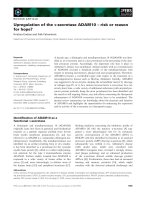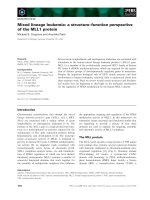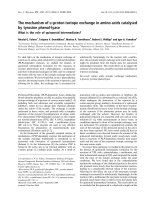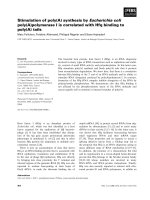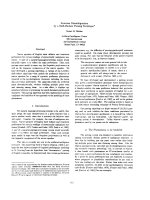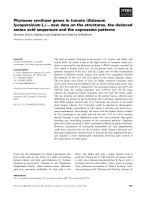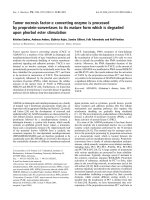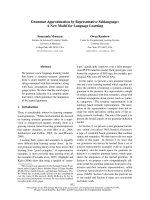Báo cáo khóa học: Hydrolytic cleavage by a group I intron ribozyme is dependent on RNA structures not important for splicing pot
Bạn đang xem bản rút gọn của tài liệu. Xem và tải ngay bản đầy đủ của tài liệu tại đây (543.15 KB, 10 trang )
Hydrolytic cleavage by a group I intron ribozyme is dependent
on RNA structures not important for splicing
Peik Haugen
1,
*, Morten Andreassen
2
,A
´
sa B. Birgisdottir
2
1
and Steinar Johansen
1,2
1
Department of Molecular Biotechnology, Institute of Medical Biology, University of Tromsø, Norway;
2
Faculty of Fisheries and
Natural Sciences, Bodø Regional University, Norway
DiGIR2 is the group I splicing-ribozyme of the mobile twin-
ribozyme intron Dir.S956-1, present in Didymium nuclear
ribosomal DNA. DiGIR2 is responsible for intron excision,
exon ligation, 3¢-splice site hydrolysis, and full-length intron
RNA circle formation. We recently reported that DiGIR2
splicing (intron excision and exon ligation) competes with
hydrolysis and subsequent full-length intron circularization.
Here we present experimental evidence that hydrolysis at the
3¢-splice site in DiGIR2 is dependent on structural elements
within the P9 subdomain not involved in splicing. Whereas
the GCGA tetra-loop in P9b was found to be important in
hydrolytic cleavage, probably due to tertiary RNA–RNA
interactions, the P9.2 hairpin structure was found to be
essential for hydrolysis. The most important positions in
P9.2 include three adenosines in the terminal loop (L9.2) and
a consensus kink-turn motif in the proximal stem. We sug-
gest that the L9.2 adenosines and the kink-motif represent
key regulatory elements in the splicing and hydrolytic reac-
tion pathways.
Keywords: Didymium iridis; group I intron; ribozyme
hydrolysis; RNA processing; RNA structures.
A highly conserved catalytic core is responsible for the
self-splicing reactions of group I intron ribozymes [1].
The secondary structures of paired segments (P1–P10 and
the optional P11–P17) are organized into three-dimensional
domains were P4–P6 and P3–P9 form the catalytic core [2,3].
The available crystal structure of the Tetrahymena intron
ribozyme core reveals an active site preorganized to catalysis
[3], which appears to contain at least three metal ions directly
involved in the reaction [4]. The group I introns can be
divided into five main subgroups named IA, IB, IC, ID and
IE [2,5]. The great majority of the more than 1200 group I
introns recognized within nuclear rDNA belong to the
group IC1 and group IE [6]. While the Tetrahymena intron
(Tth.L1925) is a prototype group IC1 intron, the Didymium
twin-ribozyme intron Dir.S956-1 (and its DiGIR2 deri-
vative) is the best studied of the group IE introns.
Group I intron splicing is initiated by binding of an
exogenous guanosine (exoG) into the guanosine binding site
(GBS). Here, exoG is positioned for attack at the 5¢-splice
site (SS) and splicing proceeds through two consecutive
transesterification steps. In addition to the essential exon
splicing reactions, Tth.L1925 also catalyze hydrolytic clea-
vage at the 3¢-SS and the formation of truncated intron
circles [1,7]. Hydrolytic cleavage at the 3¢-SS is initiated
when the last intron nucleotide (TG) binds to the GBS prior
to exoG. Splicing and hydrolysis are competing reactions
leading to ligated exons and full-length intron circles,
respectively [7].
We have identified and examined an unusual category
of self-splicing group I introns with a complex structural
organization and function [8–11]. These twin-ribozyme
introns consist of two distinct ribozymes (GIR1 and GIR2)
and a homing endonuclease gene (HEG). The DiGIR2
ribozyme, encoded by the Didymium iridis twin-ribozyme
intron Dir.S956-1, catalyses intron splicing as well as a
pronounced 3¢-SS hydrolysis and subsequent intron circu-
larization in vitro as well as in vivo [7,8,12–14]. DiGIR2
represents the group IE introns, which has a different
structural organization than the Tetrahymena group IC1
intron. Here we report structural requirements of the 3¢-SS
hydrolysis reaction in DiGIR2, including the immediate
3¢-exon nucleotides, the P9.2 segment, and the GNRA tetra
loops in L6 and L9b.
Experimental procedures
Plasmid constructions and
in vitro
mutagenesis
3
pDiGIR2 containing the DiGIR2 ribozyme with flanking
exons is the basis for most constructs, and is previously
described [8]. The P9.2 stem deletion, as well as the L6 and
L9 GNRA to UUCG substitutions in DiGIR2, were
introduced by using the PCR based Quick Change site-
directed mutagenesis kit (Stratagene) in combination
with the following PAGE-purified oligonucleotides:
pDiGIR2 L6, OP294/OP295; pDiGIR2 L9, OP 296/OP297;
and pDiGIR2DP9.2
4
, OP382/OP383. All other plasmid
Correspondence to S. Johansen, Department of Molecular
Biotechnology, Institute of Medical Biology,
University of Tromsø, N-9037 Tromsø, Norway.
Fax: + 47 77 645350, Tel.: + 47 77 645367,
E-mail:
Abbreviations: GBS, guanosine binding site; HEG, homing
endonuclease gene; IGS, internal guide sequence; rDNA,
ribosomal DNA; SS, splice site.
*Present address: Department of Biological Sciences and Center
for Comparative Genomics, University of Iowa, Iowa City,
IA 52242–1324, USA.
(Received 30 October 2003, revised 24 December 2003,
accepted 19 January 2004)
Eur. J. Biochem. 271, 1015–1024 (2004) Ó FEBS 2004 doi:10.1111/j.1432-1033.2004.04003.x
constructs were made by cloning a PCR product into the
SmaI site of a pUC18 vector using the Sure Clone Ligation
Kit (Amersham Biosciences). PCR products were inserted
randomly into a forward of reverse position, according
to the M13 sequences flanking the multiple cloning site.
The following primer combinations were used in order
to generate PCR products from the pDiGIR2 tem-
plate. Di347, OP129/OP347; Di348, OP129/OP348; Di349,
OP129/OP349; Di350, OP129/OP350; Inv310–318, OP129/
OP486; Inv312–314, OP129/OP487;
5
D300–327, OP129/
OP488; D
6
291–299/328–333, OP129/OP489; Inv317–318,
OP129/OP592; Inv315–316, OP129/OP593; Inv310–311,
OP129/OP594; DiGIR2347, OP39/OP347; DiGIR2350,
OP39/OP350. The OP129 and OP347 primer combination
was used to generate PCR products from the pDiGIR2 L6
and pDiGIR2 L9 templates, resulting in the pDi347 L6 and
pDi347 L9 constructs, respectively. OP129 and OP5 were
used to amplify a product from pDiGIR2DP9.2
7
and
generate the pDi5DP9.2
8
plasmid. Three different L9b
mutants were generated from the following primer combi-
nations. GUAA, OP559/OP560; GUGA, OP561/OP562;
GAAA, OP547/OP548. Mutants in the P5 region were
generated from the following primer combinations. CC-GG
P5 receptor, OP549/OP550; inverted P5 receptor, OP858/
OP859; P5 hinge, OP860/OP861. Oligonucleotide sequences
used in this work are available as supplement at the RNA
Research Groups web site at />info/imb/amb.
In vitro
transcription, splicing and hydrolysis reactions
Precursor RNAs were transcribed from T7 promoters on
linearized plasmids in 25 lL
9
reactions at low magnesium
concentration (2 m
M
MgCl
2
). [
35
S]CTP[a
10; 11
S] (10 lCiÆlL
)1
;
Amersham Biosciences) was uniformly incorporated into
the RNA transcripts. The following plasmids were linea-
rized with EcoRI: pDi348, pDi349, pDi350, pDiGIR2,
pDiGIR2L6, pDiGIR2L9, pDiGIR2DP9.2
12
, pDiGIR2.347,
pDiGIR2.350, pDiGIR2, pDi347L6 and pDi347L9.
pDi5DP9.2
13
with HindIII and pDi347 with SalI. RNAs
used in quantitative experiments were cut from polyacryl-
amide gels with surgical blades and incubated in 400 lL
elution buffer (0.3
M
NH
4
Ac, 0.1% sodium dodecyl
sulfate, 10 m
M
Tris pH 8 and 2.5 m
M
EDTA pH 8) on a
rotating wheel at 4 °C over night, purified through a
0.45 l
M
single use filter (Millipore) with a 1 mL syringe,
and ethanol precipitated. RNA splicing was performed
under self-splicing conditions essentially as described [8].
Hydrolytic cleavage at the 3¢-splice site was started by
adding 15 lL of purified RNA (in DEPC
14
-treated water)
to 30 lLofpreheated(50°C) buffer. Reactions were
incubated under hydrolysis conditions (same as splicing
conditions, but without GTP) at 50°Candsamples
(5 lL) were collected, added to an equal volume of
STOP solution, and immediately frozen at )70°C.
Samples were separated on 8
M
urea/5% polyacrylamide
gels, followed by autoradiography.
Computations
To quantify RNA signals, phosphoimager screens were
scanned after one to several days of exposure and the
resulting images were analyzed by using the
IMAGEQUANT
3.3 software. The 3¢ hydrolysis products were included as
a theoretical value. Quantitative experiments involving
impaired activity RNAs were performed once, while other
experiments were reproduced between two and five times.
The hydrolysis data were fit to the nonlinear first-order
decay equation with end-point correction
F
t
¼ F
4
þ F
0
 e
Àk
obs
xt
previously described [15,16]. Here, k
obs
is the calculated
pseudo-first-order rate constant.
Results and discussion
In this work we have used a full-length splicing construct
(DiGIR2) and a 5¢-truncated DiGIR2 construct (Di347) in
mutational studies to analyze hydrolytic cleavage at the
3¢-SS (Fig. 1). Compared to DiGIR2, Di347 construct lacks
the 5¢ exon, internal guide sequence (IGS), as well as the
P1 and P2 elements.
The 3¢ exon sequences are not essential for hydrolysis
at the 3¢-splice site
Sequences flanking both the Tetrahymena and the
Physarum introns [17,18] have been shown to influence
ontherateofin vitro splicing. To test for similar effects
of the 3¢ exon on DiGIR2 hydrolytic cleavage at the
3¢-SS, mutations were introduced into the eight first
positions of the 3¢-exon sequence (Fig. 2A) and analyzed
in both the 5¢-truncated and full-length splicing DiGIR2
contexts. Precursor (Pre) RNAs were incubated under
splicing conditions in time course experiments and the
generated RNA species were separated on 8
M
urea/5%
polyacrylamide gels. Compared to the wt exon context
(Di347; Fig. 2A), no reductions in hydrolytic cleavage of
truncated transcripts were observed even when 2–8 exon
positions were changed (Di348–50). Di347 and Di350
precursor RNAs were subjected to more extensive time
course experiments including quantification of radioactive
decay from the gels using phosphoimager screens.
Fraction hydrolyzed RNA (Cut) of the precursor was
plotted vs. time (Fig. 2B) and fitted into a nonlinear first-
order decay equation. The observed rate constants (k
obs
)
are shown in Fig. 2B below the plot. Results indicate
thattheimmediate3¢-exon sequence plays only a minor
role in DiGIR2 hydrolysis, which corroborates the recent
findings of the bacterial group IC3 ribozymes of Azoar-
cus and Synechococcus pre-tRNA [19]. Same mutational
changesasinDi350wereintroducedandtestedina
DiGIR2 splicing context (DiGIR2.350). A time course
experiment of DiGIR2.350 alongside the corresponding
wild-type (DiGIR2.347) RNA is shown in Fig. 2C. The
results indicate that the 3¢ exon sequence is not
important for DiGIR2 splicing (see RNA 5), but some
reductions in hydrolytic cleavage at the 3¢-SS (see RNA
3) and subsequent intron circle formation are observed
(see RNA 1 and 6). This minor discrepancy between full-
length splicing and 5¢-truncated transcripts may be due to
RNA interaction of the proposed P10 (Fig. 1B), which is
present in the full-length splicing transcript but not the
truncated transcript.
1016 P. Haugen et al. (Eur. J. Biochem. 271) Ó FEBS 2004
Fig. 1. Schematic presentation and secondary structure model of the DiGIR2 ribozyme from Didymium iridis. (A) Schematic organization of the
Dir.S956-1 intron (named according to [34]), encoding the two group I ribozyme motifs DiGIR1 and DiGIR2, and the I-DirI homing endo-
nuclease. The 5¢-and3¢-splice sites (SS) are indicated, and flanking exon sequences are shown as open boxes. Below: the DiGIR2 (lacking DiGIR1
and I-DirIORF)andthe5¢-truncated DiGIR2 RNA (Di347) used in this study. (B) Secondary structure model of DiGIR2 (modified from [7,8]).
Intron RNA nucleotides and exon nucleotides are presented as upper case and lower case letters, respectively. Paired segments (P) and intron
nucleotides are numbered. Long-range base pairing interactions (P10 and P13) are shown, and the first transcribed nucleotide of the 5¢-truncated
Di347RNA(position40)isindicatedbyanarrow
21
. Mutant regions in P5, P6, P9b, P9.2 and 3¢ exon are boxed.
Ó FEBS 2004 RNA structures important for ribozyme hydrolysis
1
(Eur. J. Biochem. 271) 1017
GNRA to UUCG substitution of L9b, but not L6,
results in reduced 3¢-SS hydrolysis
GNRA tetra-loops have been shown to participate in
long-range RNA-RNA tertiary interactions in highly
structured RNAs, including the group I ribozymes, by
interacting with specific receptor structures [2,3,20].
GNRA tetra-loops may also function as local stabilizers
of stem-loop structures analogous to the UNCG family
of tetra-loops [21]. UNCG tetra-loops have so far not
been found to participate in tertiary RNA–RNA inter-
actions. The DiGIR2 ribozyme contains two GNRA
tetra-loops; a GUAA in L6 and a GCGA in L9b
(Fig. 1B).
To evaluate the role of L6 and L9b in 3¢-SS hydrolytic
cleavage, the GNRA loops were replaced with UUCG, and
the corresponding constructs were analyzed in a similar
approach as described above. Results from time course
experiments involving the 5¢-truncated RNAs are shown in
Fig. 3A,B. A minor reduction in observed hydrolytic rate
(k
obs
0.085–0.077 min
)1
) was observed in the L6 UUCG
substitution construct (Di347L6) compared to that of the
wild type. However, the L9b UUCG replacement
(Di347L9) resulted in a 10 fold reduction of 3¢-SS hydrolysis
Fig. 2. Analysis of DiGIR2 3¢ exon sequences in hydrolytic cleavage and self-splicing. (A) Time course experiment (0–30 min) of 5¢-truncated
DiGIR2 containing different sequence substitution within the eight first positions of the 3¢ exon. Mutant RNAs were subjected to splicing
conditions [40 m
M
Tris pH 7.5, 10 m
M
MgCl, 200 m
M
KCl, 2 m
M
spermidine, 5 m
M
dithiothreitol, 0.2 m
M
GTP]. Exon nucleotides are presented
as lower case letters and substituted positions are shaded. Pre, precursor RNA; Cut, 5¢ RNA product; 3¢SS, 3¢-splice site. (B) Di347 and Di350
RNAs subjected to hydrolysis conditions (identical to splicing conditions but without GTP) and plotted as fraction uncleaved precursor (pre/total)
vs. time. Curves were fitted to the nonlinear first-order decay equation F
t
¼ F
4
+F
0
· e
)k
obs
xt
and pseudo-first-order rate constants (k
obs
)were
calculated. k
obs
variations represent differences between independent trials. RNA bands were quantitated by phosphoimager exposure with
IMAGEQUANT
version 3.3 software. (C) Self-splicing time course experiments (0–30 min) of DiGIR2.350 and wild-type DiGIR2.347. DiGIR2.347
was constructed in order to generate a DiGIR2 equivalent to DiGIR2.350 (short-3¢ exon sequences). Cir, intron RNA circle; Pre, precursor RNA;
5¢-E, 5¢ exon; Int, Intron; LE, ligated exons.
1018 P. Haugen et al. (Eur. J. Biochem. 271) Ó FEBS 2004
rate (k
obs
0.085–0.008 min
)1
). Time course experiments
of the corresponding full-length splicing constructs
(DiGIR2L6 and DiGIR2L9, respectively) and wild-type
DiGIR2 are shown in Fig. 3C. No significant difference
with respect to hydrolysis, circle formation, and exon
splicing could be observed between processed DiGIR2 and
DiGIR2L6 RNAs. We infer that the L6 GUAA tetra-loop
is not involved in RNA–RNA tertiary interactions. How-
ever, while the L9b substitution in DiGIR2 (DiGIR2L9)
does not affect splicing (RNA5), the amounts of hydrolysis
(RNA7) and intron circle formation (RNA1) are strongly
reduced. These observations are consistent with an RNA–
RNA tertiary interaction that involves the L9b GCGA
tetra-loop.
Search for an L9b tetra-loop receptor motif in P5
L9 GNRA tetra-loops, in combination with specific recep-
tors in P5, are common tertiary interactions within group I
introns [2,20,22,23]. Two different sequence contexts in P5
of DiGIR2 were tested for a possible receptor role with
GCGA L9b. The first sequence context analyzed was based
on the findings by Inoue and coworkers [23]. They reported
that the J5/5a hinge in the Pneumocystis group IC1 intron
may function as a receptor for the L9 GAAA tetra-loop.
The correspondent region in DiGIR2 appears to be the P5
internal loop (Fig. 1B). Thus, the internal loop was deleted
(D102–107, 121–124),
15
expressed as a DiGIR2 5¢-truncation
construct, and analyzed for 3¢-SS hydrolysis. The deletion
Fig. 3. Analysis of DiGIR2 L6 and L9 GNRA tetra-loops in hydrolytic cleavage and self-splicing. (A) Time course experiment (0–30 min) of
5¢-truncated variants containing tetra-loop substitutions, subjected to splicing conditions. Di347L6 and Di347L9 have GUAA to UUCG and
GCGA to UUCG substitutions in L6 and L9, respectively. (B) Determination of hydrolytic cleavage rates, k
obs
, at hydrolysis conditions of Di347L6
and Di347L9. (C) Self-splicing time course experiments (0–30 min) of the L6 (DiGIR2L6) and L9 (DiGIR2L9) substitution constructs. See legends
to Fig. 2 for abbreviations and experimental conditions.
Ó FEBS 2004 RNA structures important for ribozyme hydrolysis
1
(Eur. J. Biochem. 271) 1019
had no effect on hydrolytic activity, consistent with that the
P5 internal loop could not serve as a GCGA L9b receptor
(data not shown).
The second context analyzed includes the second and
third base pairs in P5 stem, which harbors a potential
CU:AG (positions 97, 98, 128 and 129) receptor motif
(Fig. 1B). This motif, at the exact same position in P5, is
frequently observed in combination with GNGA L9 tetra-
loops in group IA introns [20]. Studies have shown that
different GNRA tetra-loops appear to prefer a certain
receptor motif, but with a significant cross reaction [24,25].
Here, GUGA, GUAA and GAAA tetra-loops preferen-
tially interact with CU:AG, CC:GG and a 11 nt motif,
respectively. To test for a possible P9b–P5 interaction, the
Di347 construct containing four different P9b GNRA
tetra-loop motifs (GCGA, GUGA, GUAA and GAAA), in
combination with two different putative P5 receptor motifs
at the second and third base pair positions (CU:AG and
CC:GG) were analyzed for hydrolytic cleavage. Further-
more, the CU:AG motif was inverted to a nonreceptor
sequence (GA:UC) and analyzed together with both the
wild-type GCGA and the GUGA P9b tetra-loops. Whereas
all the GNRA L9b tetra loops tested supported hydrolysis
well compared to UUCG, the wild-type tetra-loop (GCGA)
was always the most efficient one followed by GUGA.
However, no significant reduction in hydrolytic cleavage
rate with respect to wild type and mutant P5 constructs
could be found (data not shown). In summary, comparative
data support a P5 stem receptor [2,20,22], but we were not
able to gain further experimental evidence probably due to
a significant cross-reaction between the receptor motifs
used in our approach.
Deletion of P9.2 dramatically reduces 3¢-SS hydrolysis
The P9.2 paired segment is present in many nuclear
group IC1 and group IE introns, including the Tetrahym-
ena intron. However, no clear functional role has been
assigned to this peripheral structural element. To test a
possible functional importance in splicing and hydrolytic
cleavage, a deletion study of the P9.2 element was
performed. The first DiGIR2 deletion mutant to be
analyzed lacks the P9.2 structure (positions 293–331;
DiGIR2DP9.2)
16
. The corresponding 5¢-truncated and full-
length splicing constructs were transcribed and analyzed by
the same approach as described above. Time course
experiments are presented in Fig. 4, and revealed that the
P9.2 deletion dramatically reduces 3¢-SS hydrolysis
(Fig. 4A). In fact, no hydrolytic cleavage was detected in
the 5¢-truncated construct after % 24 h of incubation (data
not shown). Surprisingly, the P9.2 deletion appears to
increase the splicing efficiency of DiGIR2. Figure 4B shows
that DiGIR2)P9.2 RNA was processed to essentially excised
intron and ligated exons. Faint signals corresponding to
products of 3¢-SS hydrolytic cleavage (RNAs 3 and 7) and
intron circle formation (RNAs 1 and 6) are observed,
indicating that some hydrolytic activity are still present in
the full-length splicing construct compare to 5¢-truncated
construct.
In order to evaluate the rate of hydrolytic cleavage
catalyzed by DiGIR2 and DiGIR2DP9.2
17
, we included
the Tetrahymena ribozyme (Tth.L1925) in a comparative
analysis. RNA obtained from full-length splicing constructs
of the ribozymes was incubated under hydrolysis conditions
(without GTP). The results are presented as an autoradio-
gram (Fig. 4C) and as a plot of fraction cleaved precursor
vs. time (Fig. 4D). DiGIR2 and Tth.L1925 were found to
have very similar hydrolytic cleavage rates at their 3¢-SS at
this reaction condition with a calculated k
obs
of 0.080 and
0.073 min
)1
, respectively. The P9.2 deletion in DiGIR2
reduces the hydrolysis reaction approximately 10 fold (k
obs
% 0.007 min
)1
), which is similar to that observed in the P9b
tetra-loop substitution mutant (Fig. 3B).
Nucleotide positions within the L9.2 are essential
for hydrolysis
The observation that the P9.2 deletion dramatically affects
hydrolytic cleavage, but not splicing, suggests a more direct
role in ribozyme hydrolytic function. Two additional P9.2
deletion constructs were thus generated, and include a
proximal- (positions 291–299, 328–333) and a distal (posi-
tions 300–327) stem deletion (Fig. 5A). The corresponding
5¢-truncated constructs were transcribed and analyzed by
the same approach as described above, and found to
completely abolish the hydrolytic reaction (data not shown).
These results further support an important role of P9.2 in
3¢SS hydrolytic cleavage. We infer that the distal sequences
of P9.2 are essential as deletion of positions 300–327 did
not support hydrolysis. Furthermore, shortening of P9.2 by
the proximal deletion suggests a positional effect of the
distal sequences.
To test the importance of the P9.2 loop sequence (L9.2),
five different substitution mutants were generated in the
5¢-truncation constructs, in vitro transcribed, and subjected
to cleavage conditions. Indeed, L9.2 was found to be
essential for hydrolytic cleavage as substitution by inverting
all the L9.2 positions (positions 310–318; CGCUACAAA
to GCGATGTTT) became inactive (k
obs
less than
0.001 min
)1
;Fig.5B,C).
18
Some group I introns contain
terminal loops within the P9 domain that are engaged in
long-range base–pairing interactions, e.g. P13 between L9.1
and L2.1, and P17 between L9 and L5 [26]. Interestingly,
a putative base–pairing interaction exists in DiGIR2
between L9.2 (pos. 312–314) and L5 (pos. 114–116).
However, experiments including the L9.2 mutant (Inv312–
314) excluded this possibility (k
obs
¼ 0.077 min
)1
vs.
0.085 min
)1
of wild type; Figs 5B,C). The remaining L9.2
positions were changed in pairs (310/311, 315/316 and
317/318; Fig. 5B), and the corresponding results are
presented in Fig. 5C. All substitution mutants were found
to affect hydrolytic cleavage, with most dramatic effect at
positions 315–318 (AAAU; k
obs
¼ 0.002–0.003 min
)1
).
The impaired hydrolytic cleavage of the L9.2 substitu-
tions is rescued by high Mg
2+
concentrations in the absence
of K
+
ions.
Further biochemical characterizations of the L9.2
mutants were performed, including hydrolysis at different
mono- and divalent cation concentrations. The corres-
ponding 5¢-truncation constructs were analyzed at three
different Mg
2+
concentrations (5, 10 and 50 m
M
)and
0m
M
KCl. A surprising observation was that the presence
of 200 m
M
K
+
(standard conditions) during the reaction
has a negative effect on 3¢-SS hydrolysis. Cleavage rates
1020 P. Haugen et al. (Eur. J. Biochem. 271) Ó FEBS 2004
Fig. 4. Analysis of DiGIR2 P9.2 deletion in hydrolytic cleavage and self-splicing. (A)Timecourseexperiment(0–30min)ofDi347andDi5)P9.2
subjected to splicing conditions. (B) Self-splicing time course experiment (0–30 min) of DiGIR2 and DiGIR2DP9.2. The 3¢-SS hydrolysis and intron
circle
22;2322;23
formation are strongly reduced in DiGIR2DP9.2 compared to DiGIR2, while splicing appears unaffected. (C) Time course experiment of
DiGIR2, Tetrahymena ribozyme (Tth.L1925), and DiGIR2DP9.2, subjected to hydrolysis conditions (without GTP). DiGIR2DP9.2 was incubated
up to 21 h (1260 min) in order to complete the hydrolysis reaction for a more accurate calculation of the rate constant. M, RNA size marker.
(D) Plot of fraction uncleaved precursor (pre/total) vs. time of the hydrolysis reactions presented in (C), and subsequent determination of
corresponding rate constants (k
obs
). See legends to Fig. 2 for abbreviations and experimental conditions.
24
Ó FEBS 2004 RNA structures important for ribozyme hydrolysis
1
(Eur. J. Biochem. 271) 1021
were found to be significantly higher at 10 m
M
Mg
2+
with
0m
M
K
+
than 10 m
M
Mg
2+
with 200 m
M
K
+
(compare
Figs 5C and 6). Furthermore, the impaired hydrolytic
cleavage in the mutant constructs is rescued by increasing
the Mg
2+
concentrations, and at 50 m
M
all the mutants
are at, or close to, the wild type level rate (Fig. 6).
Inhibition of Mg
2+
-dependent ribozymes by monovalent
cations has previously been noted [27–29], and suggested
to be due to monovalent cations displacement of Mg
2+
from essential sites within the ribozymes [27]. Experiments
using the hammerhead ribozyme showed that instead of
having a coordinated stimulating effect on ribozyme
activity, Na
+
ions inhibit divalent ion mediated ribozyme
reactions at lower concentrations, while rescuing the
negative effect at higher (>3
M
) concentrations [29]. Our
observation that the impaired hydrolytic cleavage of the
L9.2 substitutions is rescued by high Mg
2+
concentrations
only in the absence of monovalent K
+
ions suggests that
magnesium plays an important role in hydrolysis, but is
being displaced (maybe from L9.2) in the presence of
monovalent ions.
Fig. 5. Analysis of DiGIR2 P9.2 substitutions and deletions in hydro-
lytic cleavage. (A) Secondary structure presentations of P9.2 and the
P9.2 deletions (dashed lines) introduced into 5¢-truncated DiGIR2
ribozymes. (B) Nucleotide substitutions introduced into the L9.2 loop
region of the 5¢-truncated DiGIR2. (C) Plot of fraction uncleaved
precursor (pre/total) vs. time of the hydrolysis reactions presented in B
(hydrolysis conditions), and subsequent determination of corres-
ponding rate constants (k
obs
). See legends to Fig. 2 for abbreviations
and experimental conditions.
Fig. 6. The effect of DiGIR2 L9.2 substitutions on hydrolysis by
increased Mg
2+
concentration. Time course experiment (0–150 min) of
the wild type DiGIR2 and L9.2 substitution constructs schematically
presented in Fig. 5B at hydrolysis conditions with different magnesium
concentrations, but at 0 m
M
KCl. See legends to Fig. 2 for abbrevia-
tions and experimental conditions.
1022 P. Haugen et al. (Eur. J. Biochem. 271) Ó FEBS 2004
Functional implications of P9.2 in hydrolysis
Our finding that P9.2 is an essential structural element in
hydrolytic cleavage, but does not affect splicing, contrasts
experimental data from the Tetrahymena group IC1 intron.
P9.2 has been shown to be nonessential for splicing and
3¢-SS hydrolysis [30], but a deletion construct lacking both
P9.1 and P9.2 had a significant decrease in the folding rate
of the catalytic core [31]. The detailed global structure of
Tetrahymena P9.2 is not known as peripheral extensions
outside the catalytic core were not included in the crystal
structure determination [3], but Fe(II)ÆEDTA cleavage data
and modeling indicate that P9.2 is pointing outwards from
thecore[26].
What is the functional role of the essential L9.2 nucleo-
tides in DiGIR2 hydrolysis? One possibility is that L9.2
nucleotides participate in tertiary contacts with other parts
of the molecule. Whereas all attempts to obtain supporting
indication or evidence of regular base-pairing interactions
have failed, the important L9.2 adenosines could still be
involved in, e.g. a minor helix packing interaction in an
unidentified, distally located receptor within DiGIR2
19
[32].
An alternative possibility is that P9.2 may serve a more
direct role in hydrolytic cleavage catalysis, perhaps by
presenting hydrolysis-dependent metal-ion (e.g. magnes-
ium) to the active site, as indicated by results presented in
Fig. 6. P9.2 could potentially access the catalytic core-region
during hydrolysis analogous to P1 during splicing. Experi-
mental data from the Tetrahymena intron have provided
strong evidence that the active site contains three magnes-
ium ions directly involved in catalysis [4]. The model for
transitionstateinteractionswithintheactivesitesuggest
that two of the metal ions are bound to the guanosine
cofactor and that the third metal ion interacts with a 3¢ atom
of the nucleotide preceding the intron. However, to our
knowledge none of the metal ions have been specifically
assigned to hydrolytic cleavage.
Regardless of the exact functional role in hydrolysis of
the L9.2 nucleotides, hydrolysis is also dependent on
proximal sequences in the P9.2 stem. These sequences
harbor a consensus kink (K)-turn motif (Fig. 1B), fre-
quently observed in ribosomal RNA and other structural
RNAs as a protein binding motif [33]. The K-turn motif
in P9.2 appears essential to DiGIR2 hydrolysis as deletion
(D291–299/328–333)
20
completely abolish the 3¢-SS hydro-
lysis (Fig. 5A). The K-motif in DiGIR2 probably both
positions the essential L9.2 nucleotides for their functional
role in 3¢-SS hydrolysis, and binds to a specific nuclear
protein factor. Recently we described that DiGIR2
processing proceeds in two independent reaction pathways
(Fig. 7), one leading to intron splicing and the other to
full-length intron circularization via 3¢-SS hydrolysis [7].
Here we suggest that the K-motif in P9.2 represents a key
regulatory element between the reaction pathways, and
that a protein factor may exists in the Didymium nucleus
that participates in the regulation. The observation that
splicing appears much more efficient than hydrolysis
in vivo compared to in vitro [8,12–14] is consistent with
this proposal.
Acknowledgements
We thank Henrik Nielsen for discussions. This work was founded by
grants from Norwegian Research Council, Norwegian Cancer Society,
Aakre Foundation for Cancer Research, and Simon Fougner Hart-
manns Foundation.
References
1. Cech, T.R. (1990) Self-splicing of group I introns. Annu. Rev.
Biochem. 59, 543–568.
2. Michel, F. & Westhof, E. (1990) Modelling of the three-dimen-
sional architecture of group I catalytic introns based on com-
parative sequence analysis. J. Mol. Biol. 216, 585–610.
3. Golden, B.L., Gooding, A.R., Podell, E.R. & Cech, T.R. (1998) A
preorganized active site in the crystal structure of the Tetrahymena
ribozyme. Science 282, 259–264.
4. Shan, S., Yoshida, A., Sun, S., Piccirilli, J.A. & Herschlag, D.
(1999)ThreemetalionsattheactivesiteoftheTetrahymena group
Iribozyme.Proc. Natl Acad. Sci. USA 96, 12299–12304.
5. Shu, S.O., Jones, K.G. & Blackwell, M. (1999) A group I intron in
the small subunit rRNA gene of Cryptendoxyla hypophloia, an
ascomycetous fungus: evidence for a new major class of group I
introns. J. Mol. Evol. 48, 493–500.
6. Cannone, J.J., Subramanian, S., Schnare, M.N., Collett, J.R., Du
D’Souza, L.M.Y., Feng, B., Lin, N., Madabusi, L.V., Muller,
K.M., Pande, N. & Shang, Z., Yu, N. & Gutell, R.R. (2002) The
Comparative RNA Web (CRW) Site: an online database of
comparative sequence and structure information for ribosomal,
intron, and other RNAs. BMC Bioinform. 3, 1–31.
7. Nielsen, H., Fiskaa, T., Birgisdottir, A
˚
.B., Haugen, P., Einvik, C.
& Johansen, S. (2003) The ability to form full-length intron RNA
circles is a general property of nuclear group I introns. RNA 9,
1464–1475.
8. Decatur, W.A., Einvik, C., Johansen, S. & Vogt, V.M. (1995) Two
group I ribozymes with different functions in a nuclear rDNA
intron. EMBO J. 14, 4558–4568.
9. Einvik, C., Decatur, W.A., Embley, T.M., Vogt, V.M. &
Johansen, S. (1997) Naegleria nucleolar introns contain two group
Fig. 7.
25
Schematic representation of the functional implications for
hydrolysis in group I intron. The splicing pathway (left) is initiated by
exogenous guanosine (exoG) and results in ligated exons and spliced
out free intron. This pathway benefits the host organism. The circu-
larization pathway (right) is initiated by hydrolysis at the 3¢-splice site
(SS), at the [ohgr]G residue (TG), and results in nonspliced exons and
full-length (FL) intron circle. This pathway is a selfish feature for the
intron [7]. The hydrolysis step is dependent on the P9-domain RNA
structures P9.2 and L9b, intron structures not important in the splicing
pathway.
Ó FEBS 2004 RNA structures important for ribozyme hydrolysis
1
(Eur. J. Biochem. 271) 1023
I ribozymes with different functions in RNA splicing and pro-
cessing. RNA 3, 710–720.
10. Einvik, C., Elde, M. & Johansen, S. (1998) Group I twintrons:
genetic elements in myxomycete and schizopyrenid amoebo-
flagellate ribosomal DNAs. J. Biotechnol. 17, 63–74.
11. Johansen, S., Einvik, C. & Nielsen, H. (2002) DiGIR1 and
NaGIR1: naturally occurring group I-like ribozymes with unique
core organization and evolved biological role. Biochimica 84,
905–912.
12. Johansen, S. & Vogt, V.M. (1994) An intron in the nuclear
ribosomal DNA of Didymium iridis codes for a group I ribozyme
and a novel ribozyme that cooperate in self-splicing. Cell 25, 725–
734.
13. Vader, A., Nielsen, H. & Johansen, S. (1999) In vivo expression of
the nucleolar group I intron-encoded I-DirI homing endonuclease
involves the removal of a spliceosomal intron. EMBO J. 18, 1003–
1013.
14. Vader, A., Johansen, S. & Nielsen, H. (2002) The group
I-like ribozyme DiGIR1 mediates alternative processing of
pre-rRNA transcripts in Didymium iridis. Eur. J. Biochem. 269,
5804–5812.
15. Jabri, E., Aigner, S. & Cech, T.R. (1997) Kinetics and secondary
structure analysis of Naegleria andersoni GIR1, a group I ribo-
zyme whose putative biological function is site-specific hydrolysis.
Biochemistry 36, 16345–16354.
16. Einvik, C., Nielsen, H., Nour, R. & Johansen, S. (2000) Flanking
sequences with an essential role in hydrolysis of a self-cleaving
group I-like ribozyme. Nucleic Acids Res. 28, 2194–2200.
17. Rocheleau, G.A. & Woodson, S.A. (1995) Enhanced self-splicing
of Physarum polycephalum intron 3 by a second group I intron.
RNA 1, 183–193.
18. Cao, Y. & Woodson, S.A. (2000) Refolding of rRNA exons
enhances dissociation of the Tetrahymena intron. RNA 6, 1248–
1256.
19. Ikawa, Y., Naito, D., Shiraishi, H. & Inoue, T. (2000) Structure-
function relationships of two closely related group IC3 intron
ribozymes from Azoarcus and Synechococcus pre-tRNA. Nucleic
Acids Res. 28, 3269–3277.
20. Costa, M. & Michel, F. (1995) Frequent use of the same tertiary
motif by self-folding RNAs. EMBO J. 14, 1276–1285.
21. Varani, G. (1995) Exceptionally stable nucleic acids hairpins.
Annu. Rev. Biophys. Biomol. Struct. 24, 379–404.
22. Jaeger, L., Michel, F. & Westhof, E. (1994) Involvement of a
GNRA tetraloop in long–range RNA tertiary interactions. J. Mol.
Biol. 236, 1271–1276.
23. Ikawa, Y., Shiraishi, H. & Inoue, T. (2000) A small structural
element, Pc-J5/5a, plays dual roles in a group IC1 intron RNA.
Biochem. Biophys. Res. Comm. 274, 259–265.
24. Costa, M. & Michel, F. (1997) Rules for RNA recognition of
GNRA tetraloops deduced by in vitro selection: comparison with
in vivo evolution. EMBO J. 16, 3289–3302.
25. Ikawa, Y., Naito, D., Aono, N., Shiraishi, H. & Inoue, T. (1999)
Trans-activation of the Tetrahymena group I intron ribozyme via
a non-native RNA–RNA interaction. Nucleic Acids Res. 27,
1859–1865.
26. Lehnert, V., Jaeger, L., Michel, F. & Westhof, E. (1996) New
loop–loop tertiary interactions in self-splicing introns of subgroup
IC and ID: a complete 3D model of the Tetrahymena thermophila
ribozyme. Chem. Biol. 3, 993–1009.
27. Chowrira, B.M., Berzal-Herranz, A. & Bruke, J.M. (1993) Ionic
requirements for RNA binding, cleavage, and ligation by the
hairpin ribozyme. Biochemistry 32, 1088–1095.
28. Kuo, T.C. & Herrin, D.L. (2000) A kinetically efficient form of the
Chlamydomonas self-splicing ribosomal RNA precursor. Biochem.
Biophys. Res. Commun. 273, 967–971.
29. Zhou, J.M., Zhou, D.M., Takagi, Y., Kasai, Y., Inoue, A., Baba,
T. & Taira, K. (2002) Existence of efficient divalent metal ion-
catalyzed and inefficient divalent metal ion-independent channels
in reactions catalyzed by hammerhead ribozyme. Nucleic Acids
Res. 30, 2374–2382.
30. Ikawa, Y., Ohta, H., Shiraishi, H. & Inoue, T. (1997) Long–range
interaction between the P2.1 and P9.1 peripheral domains of the
Tetrahymena ribozyme. Nucleic Acids Res. 25, 1761–1765.
31. Zarrinkar, P.P. & Williamson, J.R. (1996) The P9.1 – P9.2 per-
ipheral extension helps guide folding of the Tetrahymena ribo-
zyme. Nucleic Acids Res. 24, 854–858.
32. Nissen, P., Ippolito, J.A., Ban, N., Moore, P.B. & Steitz, T.A.
(2001) RNA tertiary interactions in the large ribosomal subunit:
the A-minor motif. Proc.NatlAcad.Sci.USA98, 4899–4903.
33. Klein, D.J., Schmeing, T.M., Moore, P.B. & Steitz, T.A. (2001)
The kink-turn: a new RNA secondary structure motif. EMBO J.
20, 4214–4221.
34. Johansen, S. & Haugen, P. (2001) A new nomenclature of group I
introns in ribosomal DNA. RNA 7, 935–936.
1024 P. Haugen et al. (Eur. J. Biochem. 271) Ó FEBS 2004

